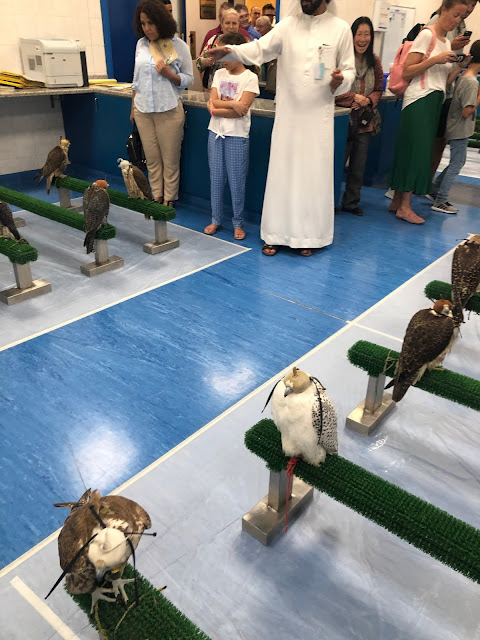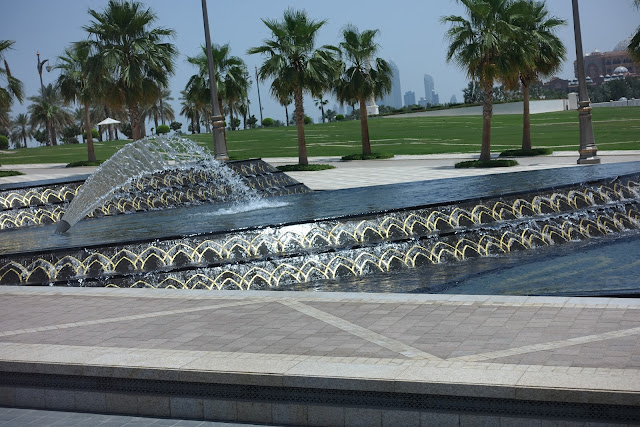Sally and I pulled into Abu Dhabi with our Global Scavenger Hunt fellow travelers around 10:00 p.m. Wiped out and grossly sweaty from a wickedly hot day of running around Bangkok, everyone was craving a shower and comfortable bed.
How about two nights at the St. Regis? Oh baby! Yes!
Thinking it might be nice to enjoy a glass of wine in the lobby with some fellow travelers, we thought wrong. Muslim country. No alcohol in the lobby. Rather than go into the bar, which was peppered with people who looked well dressed and showered, we gave up and went to our room. That turned into in-room dining and in-room drinking from a silver tray.
Bill Chalmers, the Global Scavenger Hunt’s leader, let us sleep in and relax over the hotel’s beautiful breakfast buffet. We all met at 9:30 a.m. to receive our book of scavenges for the United Arab Emirates.
This would be our last day. Back when Sally and I first planned to participate in this competition, we knew would leave halfway. Alas, our departure day had arrived.
We hustled over to the hotel concierge desk to get a map, ask a bunch of questions, and plan out the day. If we were competing, it would have been a violation of the rules to get any help from a hotel concierge. The point of the Global Scavenger Hunt trip is to get out of your comfort zone, walk out of the hotel and start talking to people in the street. We used the concierge anyway because: (a) we wouldn’t be competing anymore and (b) we wanted to make the most of our one day in Abu Dhabi. During this leg, the rules did allow using smart phones for calling and internet research. The day’s scavenges required two foods and at least one that is classified as an “experience,” rather than just going and looking at something. We did two experiences: the Falcon Hospital and kayaking.
Here are some of the things we chose to do.
1. Presidential Palace (See separate blog entry)
2. Sheikh Zayed Grand Mosque.

This giant white mosque is so big that the numbers I throw at you are numbing and hard to comprehend. There are over 80 marble domes, 1,000 pillars and four minarets. Of the multiple chandeliers, the largest weighs 11 tons and is made of Swarovski crystals and 24 carat gold. The floor is covered by the world’s largest loomed carpet that took 1200 craftspeople two years to make.

The crowd-handling of visitors evokes American entertainment attractions. Think Disney. A giant parking lot is filled with tour buses. Our taxi dropped us at the top of the escalator to begin the entrance process. The escalator empties out at a Cinnabon store. As we followed the pathway to the entrance, we were routed by clothing and souvenir shops and finally by an usher sorting people based on whether they had an advance timed reservation or not. We did (Thank you, Concierge). Inspectors determined if visitors were dressed modestly enough. If not, you had to borrow long pants, long sleeves and head scarves. Fortunately, we knew that and had arrived with our longs and longs and our head scarves on. We were waved on through.
Next stops were:
3. Falcon Hospital (See separate blog entry)
4. Kayaking (Again, a separate blog entry)
5. Qasr Al Hosn Fort (Yep, yet another blog entry) - Not a scavenge but we wanted to see it.
6. Fish Market
At the Fish Market, the scavenge was to price three exotic species. That was easy. In the frame of a single photo, we spotted Jesh, Magroor and Biyah.
7. Enjoy a “truly fresh meal in the fish market.” The market is so clean and the fish is so fresh that it does not even smell fishy. Separate establishments with ovens and counters line the outside walls of the market to cook the fish that customers bring to them from the market. Instead of going fish shopping, we chose to eat at a regular restaurant, Al Shader, where we had grilled shrimp and sea bream. The food was delicious.
8. Have a golden cappuccino at the Emirates Palace Hotel.
The hotel is another massive behemoth of gold architecture, with hallways and shops all selling similar jewelry, designer clothes and watches, sharing the same esthetic. If it’s big, gold, gaudy and a lot of, that means it’s beautiful, right? Is beauty suggesting how much money you have by showing how much you spend? In the lobby bar, cappuccino is served with flakes of gold sitting on top of the foamed milk. It looks lovely until you hold it up to your face and laugh or sneeze. The gold powder goes flying like pixie dust. Pretty funny.
9. With less than one hour left before deadline, we had to do one more food scavenge. We had to find halwa, lokhemat and mehalabiya.
Of course that required figuring out what they were. We found all three in the Emirati and the Lebanese restaurants in the ground floor of the Emirates Palace Hotel.
 |
| Lokhemat (basically, fried donuts on a stick with honey) |
 |
| Halwa |
We arrived back to our hotel just in time for the deadline. Of course it didn’t matter if we met the deadline. We couldn’t win because we didn’t stay in the game. But a major point of the Global Scavenger Hunt is to engage in conversation. All throughout the day, we talked with people we met and we learned a lot about people’s lives, the countries they came from, and why. Mission accomplished.























































